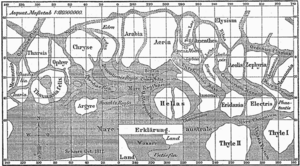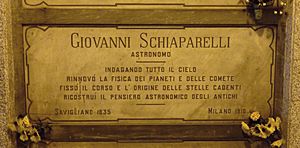Giovanni Schiaparelli facts for kids
Quick facts for kids
Giovanni Schiaparelli
|
|
|---|---|

Giovanni Schiaparelli
|
|
| Born |
Giovanni Virginio Schiaparelli
14 March 1835 Savigliano, Kingdom of Sardinia
|
| Died | 4 July 1910 (aged 75) |
| Nationality | Italian |
| Scientific career | |
| Fields | Astronomy |
Giovanni Virginio Schiaparelli (pronounced SKAP-ə-REL-ee or skee-AHP, born March 14, 1835 – died July 4, 1910) was an important Italian astronomer. He also studied the history of science. He is most famous for his observations of the planet Mars.
Contents
Discovering Giovanni Schiaparelli
Giovanni Schiaparelli studied at the University of Turin and finished his degree in 1854. He then did research at the Berlin Observatory. From 1859 to 1860, he worked at the Pulkovo Observatory near Saint Petersburg. After that, he spent more than 40 years working at the Brera Observatory in Milan.
Schiaparelli was also a senator in the Kingdom of Italy. He was a member of several important science groups, like the Accademia dei Lincei. He is especially known for his detailed studies of Mars.
Mars and its "Canals"

One of Schiaparelli's biggest contributions was his observations of Mars using a telescope. He was the first to name the "seas" and "continents" on Mars. In 1877, during a time when Mars was very close to Earth, he saw many straight lines on its surface. He called these lines "canali" in Italian.
The word "canali" means "channels" in Italian. It suggests natural features, like riverbeds. However, when his work was translated into English, "canali" was incorrectly translated as "canals." The word "canals" makes people think of artificial structures, built by someone.
The Idea of Martian Life
Because of this wrong translation, many people started to believe there might be intelligent life on Mars. This idea became very popular. It led to many theories and stories about "Martians." An American astronomer named Percival Lowell strongly believed in these artificial canals. He spent much of his life trying to prove that intelligent beings lived on Mars.
After Lowell passed away in 1916, most astronomers agreed that the canals were not real. But the idea of Martians building canals stayed popular for a long time. It even inspired many classic science fiction stories.
Debunking the Canals
Later, other astronomers, like the Italian Vincenzo Cerulli, showed that these famous channels were actually just optical illusions. People finally stopped believing in Martian canals when spacecraft began visiting Mars in the 1960s. Missions like Mariner 4 took clear pictures of the surface. These pictures showed that there were no structures like canals on Mars.
Schiaparelli himself wrote in his book Life on Mars: "Instead of true channels familiar to us, we must imagine depressions in the soil that are not very deep. They stretch in a straight direction for thousands of miles, over a width of 100, 200 kilometers and maybe more." He also thought these channels might help water spread on the dry planet.
Other Astronomy Discoveries

| 69 Hesperia | 29 April 1861 | MPC |
Schiaparelli studied many objects in our Solar System. He observed binary stars, which are two stars orbiting each other. On April 29, 1861, he discovered a large asteroid called 69 Hesperia.
He also showed that meteor showers are linked to comets. For example, he proved that the path of the Leonid meteor shower matched the path of the comet Tempel-Tuttle. This led him to believe that meteor showers are actually trails of dust left behind by comets. This idea was later proven correct.
Schiaparelli also carefully observed the inner planets, Mercury and Venus. He drew maps of them and tried to figure out how fast they spin. In 1965, scientists found that his measurements for Mercury's spin were not quite right.
Schiaparelli was also very interested in the history of old astronomy. He was the first to understand that the ideas of Eudoxus of Cnidus and Callippus about concentric spheres were not meant to be real physical objects. Instead, they were like mathematical tools to explain how planets moved.
Awards and Things Named After Him
Awards
- Lalande Prize (1868)
- Gold Medal of the Royal Astronomical Society (1872)
- Bruce Medal (1902)
Named After Him
- The asteroid 4062 Schiaparelli
- The lunar crater Schiaparelli on the Moon
- The Martian crater Schiaparelli on Mars
- Schiaparelli Dorsum, a ridge on Mercury
- The 2016 ExoMars' Schiaparelli lander, a spacecraft that landed on Mars.
Selected Writings
- 1873 – Le stelle cadenti (The Falling Stars)
- 1893 – La vita sul pianeta Marte (Life on Mars)
- 1925 – Scritti sulla storia della astronomia antica (Writings on the History of Classical Astronomy)
See also
 In Spanish: Giovanni Schiaparelli para niños
In Spanish: Giovanni Schiaparelli para niños


